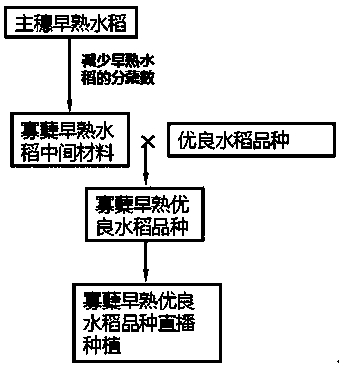Method for cultivating very early-maturing rice
A cultivation method and rice technology, applied in the field of crop genetics and breeding, can solve the problems of restricting cultivation, inconsistency in the whole plant maturity of extremely early maturing materials for main panicles, restricting popularization and application, etc., and achieving the effect of reducing the number of tillers
- Summary
- Abstract
- Description
- Claims
- Application Information
AI Technical Summary
Problems solved by technology
Method used
Image
Examples
Embodiment 1
[0029] Embodiment 1: Utilize hybridization method to create oligo-tiller early-maturing rice material
[0030] Using a short-growing rice mutant sgp(t) (characterized by early maturation of the main panicle) (Liu Huaqing et al. (2008), Science Bulletin, 53(13):1552-1559, image 3 ) was hybridized with the oligo-tiller rice variety Nanchanghui, the hybrid F1 was self-crossed after planting, and F2 seeds were obtained, and a F2 population of 1500 plants was planted; the heading stage of the main panicle, tillering, and maturity of the whole plant were investigated on a single plant basis, and other agronomic traits were investigated in combination. Select plants with compact and upright leaves, plant height less than 1m, seed setting rate above 85%, main panicle sowing start within 50 days, oligotillers (total number of panicles ≤ 3), and whole plant maturity within 90 days to harvest as a single plant , planted into F3 strains; then select and plant F4, F5, F6 according to the ...
Embodiment 2
[0031] Example 2: Using genome editing technology to create oligo-tiller early-maturing rice materials
[0032] 1. Genome editing target site selection and vector construction
[0033] Selection of rice ideal plant type gene IPA1, using PCR to amplify short growth period mutant sgp(t) background IPA1 Gene sequence, after sequencing, it was found that its IPA1 The gene sequence is consistent with that of Nipponbare. According to the principle of CRISPR / CAS9 target site design, two target sites were selected in the miRNA156 binding site area, and their sequences were:
[0034] CIPA1-1, TCTCTTCTGTCAACCCAGCCATGG;
[0035] CIPA1-2, TCTCTCTCTTCTGTCAACCCAGC.
[0036] The backbone of the plant Cas9 / gRNA plasmid (VK005-01 Cas9 / gRNAVector) provided by Beijing Weishang Lide Company was used, which already included the 35S promoter and its hygromycin resistance gene, the Ubi promoter and its The optimized Cas9 protein adapted to rice and the rU6 promoter that starts the gRNA also i...
Embodiment 3
[0049] Embodiment 3: oligo-tiller early-maturing rice variety cultivation
[0050] Utilize the early-maturing oligo-tiller rice intermediate material created in Example 1 fte Hybrid rice varieties Minghui 86 and 93-11 were crossed, the hybrid F1 was backcrossed with the corresponding Minghui 86 and 93-11 respectively, and the backcross generation 1 (BC1) plants with early heading and oligotillers were selected to continue backcrossing with the recurrent parents. The 5th generation of backcross (BC5) plants were self-crossed to obtain homozygous oligotiller early-maturing rice varieties Zaomaming Minghui 86 (E86) and Zaoma 93-11 (E9311) with the background of recurrent parents. Their growth periods were 76 days and 78 days.
PUM
 Login to View More
Login to View More Abstract
Description
Claims
Application Information
 Login to View More
Login to View More - R&D
- Intellectual Property
- Life Sciences
- Materials
- Tech Scout
- Unparalleled Data Quality
- Higher Quality Content
- 60% Fewer Hallucinations
Browse by: Latest US Patents, China's latest patents, Technical Efficacy Thesaurus, Application Domain, Technology Topic, Popular Technical Reports.
© 2025 PatSnap. All rights reserved.Legal|Privacy policy|Modern Slavery Act Transparency Statement|Sitemap|About US| Contact US: help@patsnap.com



